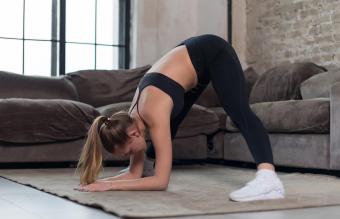
Dolphin pose (Ardha Pincha Mayurasana) may also be called the half peacock or peacock feather preparation pose. This asana is a beginning to intermediate inversion posture that many yogis use when working up to performing headstands or other, more advanced inversion poses.
Performing Dolphin Pose
To flow into this asana, begin on your hands and knees or modify by starting from a posture like child's pose.
- Starting on your hands and knees, keep your elbows soft and position your hands parallel to the sides of your yoga mat directly under your shoulders. Align your knees directly under your hips.
- Lower your elbows and forearms to the floor, keeping your hands and knees in the same position. As you do this, lower your head so your forehead is just above or lightly touching the floor (child's pose).
- Curl your toes into the mat and press your pelvis towards the ceiling. Begin to straighten your legs, pressing your feet and forearms/hands into the floor until you are in an inverted V position, resting on your forearms and your toes with your bottom straight up towards the ceiling and your legs straight. Maintain a shoulder-width distance with your feet.
- To stretch your calves, press your heels gently towards the floor. Hold your head in a relaxed position just touching or slightly above the floor with your eyes gazing backwards between your knees.
- Breathing deeply, hold the pose for five to 10 breaths before exhaling and gently lowering your knees to the floor to enter child's pose.
Modifications
Dolphin pose is a good modification of downward facing dog for people who have wrist pain. To modify dolphin pose for beginners, try the following:
- Enter the pose in stages from child's pose, raising just as far as you can into the pose until you have the strength and flexibility to complete the asana.
- Use a folded towel or cushion under your knees (or wear knee pads) from the starting position to protect tender knees.
- In the final pose, only press your heels as far towards the ground as you can without pain, which will gently stretch calves. As calf flexibility increases, you may be able to press your heels lower to the ground.
- Place a block between your hands/forearms if your wrists are weak.
- Place a block under your heels for tight calves.
Benefits
Dolphin pose offers benefits for the body, mind, and spirit. According to Yoga Journal, benefits of dolphin pose include the following:
- Strengthens core muscles
- Strengthens upper body
- Stretches calves and hamstrings
- Stretches foot arches
- Stretches the backs of shoulders
- Improves spinal alignment
- Helps calm depression and anxiety
- Stimulates the pineal gland (which makes the sleep regulating hormone melatonin) which can help with sleep issues, such as insomnia
- May help relieve menopausal and menstrual symptoms
Spiritual Significance
Ardha Pincha Mayurasana, like other inversion poses, allows energy to flow to the pineal gland, which is associated with your crown chakra. This energy center, located at the top of your head, connects you to a higher perspective, allowing you to take a broader view of your life's circumstances and events.
Great for Beginners
This asana is a good starting inversion pose for beginners who wish to work up to asanas requiring more strength and/or flexibility. It's also an excellent part of a daily yoga routine for strengthening your core, stretching your legs, and calming your mind.







